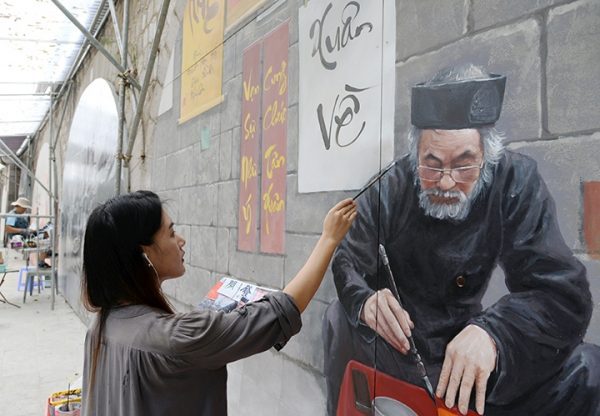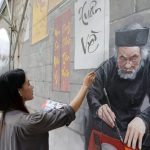It is a fresco street on Phung Hung Street where comers have a chance to not only retrieve the memories of the capital’s historical periods but also find moments of contemplation in the mid of the urban noisy life.

A painter is drawing a large fresco on the bridge dome on Phung Hung Street, Hanoi. Photo by Thuy Nguyen
Reproduction of heritage memories
These days, passing Phung Hung Street, the approach to Long Bien bridge, we found many strange things. The sidewalks attached to the eastern domes of the street, which were previously occupied for ice tea stalls, beer boutiques, and parking lots, have been now cleaned and prepared for paving. The wall of the domes to Long Bien bridge is being enthusiastically painted by Vietnamese and Korean painters.
With the theme “Heritage Memories”, 19 frescoes, once completed, will cover the rough stone wall that is blocking the bridge’s domes, bringing a new, lively look to the area. This is an activity within the “Frescoes on Phung Hung Street” project coordinated by the People’s Committee of Hoan Kiem District, the UN-Habitat and the Korea Foundation.
Phung Hung Street has a railway approach to Long Bien Bridge which is the urban heritage area of Hanoi. During the capital’s development, this place has also undergone many changes. According to architect Tran Huy Anh (National University of Civil Engineering), Phung Hung Street was built on the foundation of a notch surrounding Hanoi, which filled when the citadel wall was demolished in 1889. This street appeared simultaneously with the railway, connecting Hang Co railway station to Long Bien bridge (1902).
Over the years, many researchers, scientists, and overseas Vietnamese loving Hanoi have proposed various ideas to renovate and improve this area. nevertheless, for different reasons, no idea has come true. Vice Chairman of the People’s Committee of Hoan Kiem District Pham Tuan Long said: “This is one of the areas associated with the capital’s history for years, proposed to be conserved and developed by numerous scientists, historians and cultural activists. In mid-2017, through the introduction of the UN-Habitat, we started working the Korea Foundation, which has implemented the fresco village in Quang Nam. The two parties conducted many surveys for the “Frescoes on Phung Hung Street” project. Acknowledging the project’s complexity, we carried out studies and proposals to renovate Hanoi city. This is the first phase of the project, so we chose to decorate with the paintings, shortening the duration and promoting the heritage values here at the lowest rate of investment.
A new additional cultural space
the community art model is not new In many countries around the world. In Vietnam, Korean painters have drawn frescoes in a village of Tam Thanh commune (Tam Ky city, Quang Nam province). Although the frescoes on Phung Hung Street project is quite new to Hanoi, according to researcher Tran Hau Yen The, lecturer at the Vietnam University of Fine Arts, Hanoi, the contents of the frescoes are conveyed in a unique way. “For a city of more than a thousand years old like Hanoi, a community art project with the theme of “Heritage Memories” is pretty reasonable. Despite dealing with only one very small aspect of the heritage, the project itself meets people’s expectations. Tam Thanh also has a fresco village which is not about memories; On Phung Hung Street, the paintings “tell” the story of the street, there are works that can not be taken anywhere, but be attached to that street only”, he added.
Hanoi possesses a thousand-year history with rich heritages which have not been much expanded to serve people’s needs for cultural and entertainment sites. Besides the ceramic road which is considered the first community project, the “Frescoes on Pho Hung Street” is the second one in the capital. According to experts, with this name, it must first benefit the community. While making the dyke-side street beautiful, the ceramic road cannot become a cultural space for the community because of its unfavourable location. Meanwhile, Phung Hung Street, thanks to the advantages of its association with the old town, walking street, etc., is expected to connect with the surrounding area, to become the destination for tourists, making the neighbourhood more civilized. Ms. Pham Thanh Huong, Head of UNESCO’s Cultural and Science Committee in Vietnam, said: “The street may be an artistic place for artists to develop their ideas. It is important that the community art project must benefit the people”.
This was also affirmed by Mr. Pham Tuan Long: “Because the fresco street is close to the traditional flower market for Tet holiday and the traditional Mid-Autumn Market in Hang Luoc, it will become the venue for cultural activities in Hoan Kiem District, serving the people of the capital and tourists”.
Mr. Lee Kang Jun, Artistic Director of the project shared, “I am very honoured to be involved in this community art project – part of a scheme to develop the old town of Hanoi. In the main light of “Memories of Hanoi”, we want to present a picture of both past and present Hanoi on the frescoes painted by Korean and Vietnamese painters. Upon this project’s completion, I hope further community art projects will be executed and this street will become one of the most attractive places in the Old Town”.
Many people in the capital were very happy that recently the face of Hanoi has changed, the city space is being renovated in depth towards expanding the cultural space, paying more attention to the benefits of the community. Ms. Hoang Thi Chinh, a resident of Hang Luoc Street, said: “The beautiful street will make people more proud and responsible for conservation”.
In recent years, Hanoi has welcomed an increasing number of domestic and foreign tourists.
Hanoi attracts tourists by its cultural values and long history, with a lot of cultural aspects and heritages hidden deeply behind its peace. Apart from creating an additional destination and a new cultural space in the capital, Phung Hung Fresco Street, if well implemented, will be also one of the attractive ways of promoting Hanoi’s culture and people.

